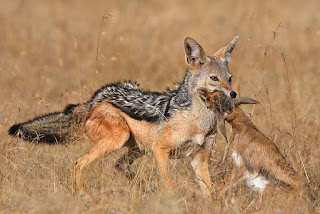
Jackal belongs to the canine species. Africa, the Middle East, India, and the southeastern regions of Europe are all home to it. The Golden Jackal, Side-striped Jackal, and Black-backed Jackal are the three different species of jackals. They vary in terms of size, fur color, and habitat type. Jackals can live in a variety of habitats, including deserts, savannas, grasslands, marshes, woodlands, and mountains. Due to habitat loss and killing, some jackal populations are in danger.
The size of jackals varies by species. Jackals typically weigh between 15 and 35 pounds and stand between 15 and 20 inches tall at the shoulder.
Black fur in shades of golden, rust, or silver covers the jackal’s body. The tail of jackals is bushy.
Jackals are flexible feeders. That implies that they will consume whatever is offered. Snakes and other reptiles, smaller gazelles, sheep, insects, fruit, berries, and occasionally even grass are among the prey that jackals enjoy eating.
Occasionally, jackals will consume the remains of animals that were killed by powerful predators.
Jackals can live alone, in a pair, or as a part of a large group known as a pack. Living in a pack ensures protection from predators and cooperative hunting, which results in the larger prey being killed.
Leopards, hyenas, and eagles are the primary predators of jackals. Eagles prey on young animals in particular.
Jackals are a territorial species. They aggressively mark and defend their territory.
Jackals are swift creatures. They can run at 40 miles per hour, but for longer periods of time, they usually only run at 10 miles per hour.
Jackals are extremely vocal creatures. They communicate using a wide range of sounds. Yips, howls, growls, and “owl-like hoots” are among the most notable sounds. When the food is found, a siren-like howl is produced.
Jackals only respond to sounds made by members of their family. All other calls are ignored.
The mating season is determined by the geographic distribution of jackals. Jackals in Africa mate in October, jackals in Southeast Europe mate in December, and jackals in India mate all year.
Jackals have life-long relationships (they are monogamous). Female pregnancy lasts about 2 months and usually results in 2 to 4 cubs. Large litters can have up to 9 cubs.
Babies are born in caves, rock crevices, or underground dens. Mother moves the den every two weeks to keep large predators away from her babies. Babies are blind for the first ten days of their lives.
During the first few months, children rely on their mothers’ milk and meat regurgitated by other family members. Children will learn to hunt on their own at the age of six months. To increase their chances of survival, older pups look after younger pups.
Jackals can live in the wild for 8 to 9 years and in captivity for up to 16 years.








